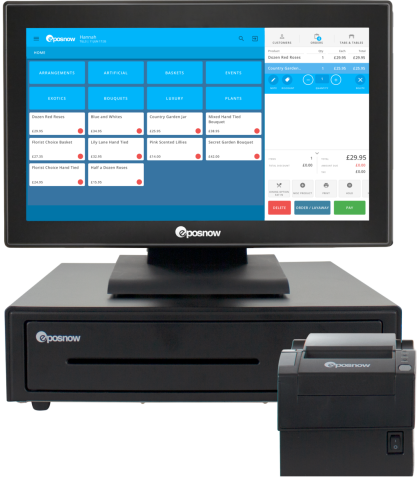Retail Performance and How To Improve and Measure It
As a retailer, you know just how important it is to keep track of your store's performance and ensure that it is running smoothly. But knowing where to start can be tricky - what do you measure? How often? How do you interpret the data?
This blog post will explore what retail business performance metrics and how to use them to improve your store's performance. We will also look at key performance indicators (KPIs) that you should be tracking and how to measure them to get the most out of your business.
Let's get started.
What is a retail store?
A retail store is a business that sells goods directly to consumers. This can include clothing stores, convenience stores, bookstores, and hardware stores. The goal of a retail store is to generate as much revenue as possible, increase foot traffic and improve customer satisfaction.
Type of retail stores
Retail stores come in all shapes and sizes. Here are some retail businesses that you could have:
- Clothing Stores
- Furniture Stores
- Jewellery Stores
- Grocery Stores
- Bookstores
- Electronics Stores
- Barber Shops
- Vape Shops
- Bike Shops
- Car Washes
What are retail key performance indicators (KPIs)?
KPIs are the metrics that measure how well a retail business is performing in relation to its goals. They can be used to track various aspects of a retail store, such as sales performance, customer satisfaction, product availability, and inventory management. By tracking these KPIs, you can gain valuable insights into your store's performance and make any necessary improvements.
There are several ways you people in the retail industry can measure KPIs. You can use customer surveys, sales data, and analytics to measure customer satisfaction and product availability. For inventory management, you can use barcode scanning or RFID technology to keep track of stock levels in real time.
One of the most effective ways is by using a cloud-based POS system, which allows you to track sales data in real time and access valuable insights about your store's performance. We'll go into this in more detail later.
Benefits of tracking retail business performance
Improved customer service
By tracking retail performance metrics, you can gain valuable insights into your store's performance and what areas need improvement. This will help you provide better customer service and ensure that customers have a positive experience whenever they visit your store.
For example, if you find that you are losing customers due to long lines and slow checkout times, you can use this data to improve the efficiency of your processes or invest in new technology that will speed up the checkout process.
More informed decisions
Using retail store performance metrics helps you make data-driven decisions that will positively impact your store's performance. You can use the information to inform decisions about product and service offerings, marketing strategies, and operational processes.
Suppose you have data that shows customers are more likely to purchase a product if it is presented in an attractive display. You can use this information to create eye-catching displays or invest in new display equipment.
Increased profits
By tracking retail store performance metrics, you can identify areas where you may be losing money or not performing as well as you should be. This will allow you to make the necessary changes and improvements that can help increase your store's profits.
Say you find that your store has an unacceptably high staff turnover rate. You can use this data to investigate the issue and make changes to improve employee satisfaction, such as providing better training or offering more competitive salaries and benefits.
Increased foot traffic
Tracking retail performance metrics can help you identify areas where your store is underperforming, providing opportunities for improvement. This will help you increase foot traffic and attract new customers to your business.
For example, discover that customers are not visiting certain sections of the store or leaving without making a purchase. You can use this data to make changes to the layout or product selection in order to increase sales.
Improved customer loyalty
Knowing which areas of your business need improvement and making changes accordingly can help increase customer loyalty by showing them that you are actively working to improve their experience.
For example, if customers are unhappy with your store's return policy, you can use this data to make changes and create a better policy that encourages customers to shop at your store. Or, if you find that customers are leaving your store without making a purchase, you can use this information to create incentives or discounts to encourage them to shop.
Reduced costs
By tracking retail performance metrics, you can identify areas of your business where costs are too high and make necessary changes to reduce them. This will help you save money in the long run.
Suppose you own a retail store and spend a lot on overtime due to your team manually entering data. You can use this information to invest in automated systems that will reduce the time spent on manual entry, lowering your costs and increasing efficiency.
These are just some of the benefits of tracking retail store performance metrics. Now let's look at the key metrics you should track in your store and how to measure them.
Reduced inventory turnover
Tracking metrics such as inventory levels, sales trends, and customer feedback can help you reduce excess inventory and cut down on waste. By understanding what products are selling well, you can order the right amount of stock and avoid overstocking or having to mark down prices due to a lack of demand.
Business growth
Tracking performance metrics helps you identify areas of growth and improvement in your store. By understanding where you are excelling and where there is room for improvement, you can focus on growing your business and increasing sales.
For example, find that customers are more likely to purchase a product when it is paired with complimentary items. You can use this data to inform your product offerings and create more effective promotions.

The All-in-One Retail POS System
Thrive with omnichannel selling options, multi-location inventory management, a versatile EPOS solution that meets your business needs, and more.
Retail KPIs to track
Sales revenue
Your sales revenue is one of the most important metrics to track when assessing your store's performance. This will indicate how much money your store is making and allow you to adjust your strategy accordingly.
For example, suppose you own a bookshop, and your sales revenue is lower than expected. You can use this metric to adjust your marketing tactics or consider stocking new titles in order to boost sales.
You can measure this metric both for online sales and in a physical retail space.
TIP: Our retail POS system can help you track sales revenue accurately, quickly, and easily.
Customer satisfaction rate
Customer satisfaction is essential for any successful retail business. It's important to track customer feedback to identify areas where your store needs improvement. If customers are unhappy with their experience at your store, they will likely go elsewhere.
Some ways you can measure customer satisfaction include:
- Surveys
- Social media reviews
- Customer service interactions
Conversion rate
The conversion rate is defined as the number of customers who make a purchase after visiting your store. This metric is important because it indicates how successful your sales and marketing strategies attract customers and convert them into paying customers. If you notice that your conversion rate is low, then it could be time to reassess your marketing strategies and adjust them to better meet the needs of your customers.
If you own an eCommerce store, you can easily track your conversion rate with an analytics platform like Google Analytics. Brick and mortar stores can measure your conversion rate by tracking customer visits and purchases.
Average transaction value (ATV)
The average transaction value (ATV) is the average customer spends in each transaction at your store. This metric is important because it indicates your success in driving sales and generating revenue.
For example, if your ATV is low, then this could indicate that the customer's average purchase is not high enough. You may need to focus on upselling and cross-selling to increase the ATV.
What's the difference? Upselling is when you suggest a customer purchase something more expensive than they originally intended (e.g., upgrade from a burger to a steak). Cross-selling is when you suggest that customers add on items related to the product they are already purchasing (e.g., fries with their burger).
Return rate
The return rate is the percentage of customers who return items after making a purchase. This metric can indicate customer satisfaction and whether your store is living up to customer expectations.
For example, suppose your return rate is high. In that case,this could indicate that customers are unsatisfied with their purchases or that the product quality does not match what was promised. To reduce this rate, you should focus on improving product quality and providing attentive customer service.
Stock turnover
The stock turnover metric tells you how quickly goods are sold and replenished in your store. This is an important metric because it indicates the efficiency of your inventory management system and can help you make adjustments to improve it.
Suppose you own a boutique clothing store. If your stock turnover is low, then this could indicate that items are not selling quickly enough, and you may need to adjust the items in inventory or reduce prices to increase sales.
Employee turnover
Employee turnover is the rate at which employees leave, and new ones are hired. This metric can provide insight into employee satisfaction and how well your training programs are working. If you notice that employees are leaving quickly, then this could indicate that there may be problems with job satisfaction or training opportunities. To reduce turnover, you should focus on providing employees better training and development programs and a better working environment.
Actionable tips to improve retail performance
Now that you know the metrics for measuring retail performance, here are some actionable tips to improve it:
Ways to improve your sales revenue:
- Focus on upselling and cross-selling to increase average transaction value (ATV).
- Adjust prices to find the optimal pricing point.
- Optimise product displays to make them more inviting.
- Provide discounts and promotions during peak seasons
Ways to improve your customer satisfaction rate:
- Provide better customer service and support
- Implement a loyalty program to reward customers for their purchases
- Utilise customer feedback surveys to capture customer insights
- Offer free shipping and returns to incentivize customers
- Train employees in customer service and product knowledge
Ways to improve your conversion rate:
- Optimise the website for mobile devices.
- Simplify the checkout process to reduce cart abandonment.
- Improve search engine optimization (SEO) to boost traffic and sales.
- Implement personalization tactics to target customers with relevant offers.
- Test new marketing strategies such as email campaigns and social media ads
Ways to improve your return rate:
- Improve product quality and customer service.
- Include accurate product descriptions and images on the website.
- Allow customers to return items within a certain time period.
- Provide easy-to-understand warranty information or policies
- Train staff to handle customer complaints efficiently.
Ways to improve your average transaction value:
- Focus on upselling and cross-selling to increase ATV.
- Provide incentives for customers who purchase multiple items.
- Offer discounts or free shipping when customers purchase certain amounts or products
- Optimise product displays to make them more inviting and appealing.
- Create bundles of related products that offer value-driven deals
Ways to improve your employee turnover:
- Provide better training and development programs.
- Offer competitive salaries and benefits packages to attract and retain staff.
- Create a positive work environment with opportunities for growth
- Encourage regular feedback from employees to understand their needs better.
- Implement recognition programs to reward outstanding performances
Ways to improve your stock turnover:
- Ensure accurate inventory tracking and forecasts.
- Analyse customer buying trends and adjust product mix accordingly.
- Optimise the supply chain process to reduce lead times.
- Reduce excess stock by taking advantage of promotional activities
- Make sure items are properly labelled and organised for quick restocking.
Track your retail performance with a powerful POS
A great way to improve your retail performance is to use a powerful Point of Sale (POS) system. This type of system can help you track sales, inventory, customer interactions, and more. It can also provide valuable insights into how customers purchase in-store, allowing you to make adjustments to improve the customer experience.
Using a retail or hospitality POS system is a great way to get an accurate, real-time view of your retail performance. With this system, you can easily track key retail metrics such as conversion rate, average transaction value, return rate, stock turnover, and employee turnover to ensure you are taking the right steps to improve your store's performance.
Plus, with an integrated payment processing service, can help you streamline the checkout process and reduce wait times for customers.
Final thoughts
Improving and measuring your retail store performance is essential for success.
By taking advantage of the above tips and using a powerful POS system, you can easily track key metrics to gain valuable insights into how customers purchase in-store and make adjustments as necessary.
With these strategies, you can ensure that your store stands out from the competition and drives growth. So start tracking your retail store performance today and see the results!
Want to know more about managing a retail store? Check out our retail operations management blog today!




